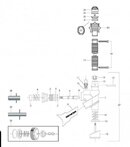- Messages
- 7,660
- Reaction score
- 4,717
- # of dives
- 200 - 499
You hit a nerve with that one.What value does checking oral inflation add if you know the assembly dumps correctly? Is there a situation that the hole may work in one direction (dumping air from the bladder) but not in the other direction (orally inflating)?
Yes, correct. Works both ways. Problem is that in an emergency our brains don't free scroll though the entirety of our training.
Let's say one of your OOA divers makes it to the surface. Drop weights, orally inflate.
One of the events that most seriously affected TSandM was a diver who made it to the surface then drowned in her presence. I took a lesson from this, I never use the inflator on the surface. Orally inflate. Muscle memory.
---------- Post added September 20th, 2015 at 06:39 PM ----------
Memory fails me slightly. Not in her presence. Read this: http://www.scubaboard.com/forums/ne...iver-please-read-post4301964.html#post4301964
---------- Post added September 20th, 2015 at 07:31 PM ----------
I keep forgetting that the masses don't want a rigorous treatment or a long read anymore. All better now.
Sound bite: "She didn't drop weights or orally inflate her BC, because she was panic-stricken from having gone out of gas."
Post #10.





